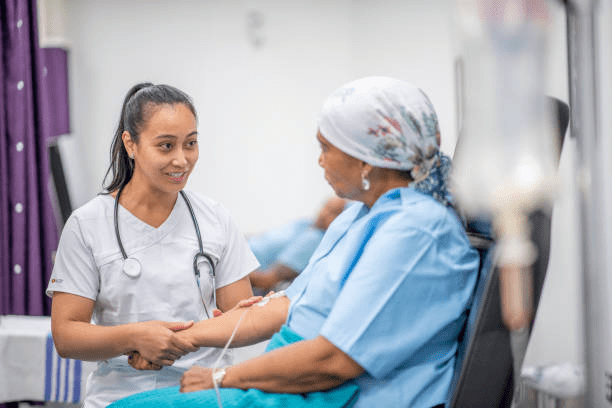Introduction – Breast Cancer 5-Year Survival Rate by Stage

Nerve Pain After Lymph Node Removal: Causes & Solutions
January 17, 2025
Fibrocystic Breasts After Menopause
March 18, 2025A breast cancer diagnosis can be life-altering, filling patients with uncertainty and fear. According to the World Health Organization (WHO), breast cancer is the most common cancer worldwide, affecting over 2.3 million women annually. One of the most pressing concerns is survival, which depends on multiple factors, including the stage at diagnosis. In India, breast cancer accounts for 25-32% of all female cancers, with survival rates varying significantly based on the stage at which the disease is detected.

According Dr. Garvit Chitkara, a prominent Breast Cancer Surgeon in Mumbai:
“Breast cancer survival rates have improved significantly over the years, thanks to early detection, advancements in treatment, and better patient awareness. However, survival statistics are not just numbers; they reflect hope, resilience, and the importance of timely intervention. While stage matters, personalized care and an integrated treatment approach can make all the difference”
Wondering how survival rates apply to your situation? Every case is unique, and personalized guidance can make all the difference. Get expert insights on your diagnosis and treatment options today!
So, what does survival look like at different stages of breast cancer? Let’s break it down.
5-Year Survival Rate for Each Stage of Breast Cancer

Understanding the breast cancer 5-year survival rate by stage helps patients and families make informed decisions about treatment and expectations. Here’s a closer look at each stage:
Stage 0 (DCIS – Ductal Carcinoma in Situ)
Stage 0 breast cancer, or DCIS, is a non-invasive form of cancer where abnormal cells are confined to the milk ducts. Since the cancer has not spread, the 5-year survival rate is nearly 100% with appropriate treatment. Early detection at this stage allows for breast-conserving surgery (lumpectomy) or mastectomy, reducing the risk of progression.
Stage 2 (Early-Stage Invasive Cancer)
Stage 2 breast cancer means the tumor is between 2-5 cm and may have spread to nearby lymph nodes. However, it has not reached distant organs. The 5-year survival rate ranges from 85-95%, depending on factors like tumor grade and hormone receptor status. A combination of surgery, chemotherapy, radiation, and targeted therapy is typically recommended to prevent recurrence.
Stage 3 (Locally Advanced Breast Cancer)
In Stage 3, cancer is larger than 5 cm or has spread to multiple lymph nodes or nearby tissues. The 5-year survival rate drops to around 65-75%. However, aggressive treatment—including surgery, chemotherapy, hormone therapy, and immunotherapy—can still lead to remission. Newer treatment approaches, such as neoadjuvant chemotherapy, help shrink tumors before surgery, improving outcomes.
Stage 4 (Metastatic Breast Cancer)
Stage 4 or metastatic breast cancer occurs when cancer spreads beyond the breast to distant organs such as the lungs, liver, bones, or brain. The 5-year survival rate for Stage 4 breast cancer is around 22%, though newer treatments are helping patients live longer and better. Treatment focuses on prolonging life and improving quality of life through a mix of targeted therapy, chemotherapy, immunotherapy, and palliative care.
While staging plays a crucial role, several other factors influence survival outcomes.
What Influences Survival Rates Beyond Staging?
Breast cancer survival rates vary across different regions, with high-income countries reporting an average 5-year survival rate of 80-90%, while India’s survival rate ranges from 66% overall to as low as 22% for Stage 4 cases. But survival isn’t just about the stage—it’s influenced by multiple factors that shape treatment outcomes.

Factors influencing survival rates include:
Tumor Biology: Hormone receptor status (ER/PR-positive or negative) and HER2 status affect treatment options and prognosis.
Age and Overall Health: Younger patients may tolerate aggressive treatments better, while existing health conditions can impact treatment response.
Treatment Response: The effectiveness of surgery, chemotherapy, and targeted therapy directly affects survival rates.
Genetics and Family History: BRCA1 and BRCA2 gene mutations can increase the risk of recurrence.
Lifestyle Factors: Smoking, obesity, and lack of physical activity can lower survival chances, whereas a healthy lifestyle improves outcomes.
Early detection can change the course of breast cancer. Don’t wait for symptoms to appear—regular screenings and timely intervention can significantly improve survival chances. Take the first step towards proactive care now!
While breast cancer survival statistics can seem daunting, numerous strategies help improve outcomes.
Improving Breast Cancer Survival

Early Detection & Regular Screening: Mammograms and self-examinations are critical for catching cancer early.
Personalized Treatment Plans: Precision medicine tailors treatments to an individual’s cancer type.
Advancements in Medical Technology: Newer targeted therapies and immunotherapies are extending survival.
Healthy Lifestyle Choices: Balanced nutrition, regular exercise, and stress management support recovery.
Support Systems & Mental Well-being: Psychological counseling and support groups help patients navigate treatment.
Dr. Garvit Chitkara, a renowned Breast cancer specialist in Mumbai, says:
“Survival isn’t just about statistics—it’s about empowering patients with knowledge, timely intervention, and a holistic approach to care. Advances in medicine, coupled with proactive screening and lifestyle changes, can dramatically improve survival outcomes. Every patient’s journey is unique, and with the right guidance, they can achieve the best possible results.”
Conclusion
Breast cancer is a complex disease, and survival rates depend on early detection, stage at diagnosis, and treatment approach. However, the fight against breast cancer isn’t just about medical interventions—it’s about staying informed, making proactive choices, and seeking the right care at the right time.
Dr. Garvit Chitkara, a highly sought-after doctor for Breast cancer treatment in Mumbai, advises:
“At every stage, there is hope. Advances in breast cancer treatment have revolutionized survival rates, but the key lies in awareness, timely action, and a personalized approach. No one has to go through this journey alone—we are here to help.”
Advancements in breast cancer treatment are transforming survival outcomes. The right approach can offer better chances of recovery and an improved quality of life. Reach out to explore cutting-edge treatment options tailored for you!
Still have questions? You’re not alone! Let’s address some of the most common concerns about breast cancer survival rates and what they mean for you.
FAQ
1. What is the 5-year survival rate for breast cancer in India?
The 5-year survival rate varies by stage, ranging from nearly 100% for Stage 0 and Stage 1 to around 22% for Stage 4. Early detection through screening programs significantly improves survival.
2. Can Stage 4 breast cancer be cured?
While Stage 4 breast cancer is not considered curable, advancements in targeted therapy, immunotherapy, and personalized treatments are helping patients live longer with a better quality of life.
3. What lifestyle changes improve breast cancer survival?
Regular exercise, a balanced diet, avoiding smoking and alcohol, managing stress, and maintaining a healthy weight can enhance overall well-being and reduce the risk of recurrence.
4. Does family history impact breast cancer survival?
Yes, individuals with a family history of breast cancer or BRCA gene mutations may have a higher risk of recurrence. Genetic counseling and preventive measures can help improve outcomes.
5. How often should breast cancer survivors go for follow-ups?
Breast cancer survivors should have regular follow-up appointments every 3-6 months in the first few years, followed by annual check-ups to monitor for recurrence and overall health.
Reference Links:
https://www.cancerresearchuk.org/about-cancer/breast-cancer/survival
Disclaimer: The information shared in this content is for educational purposes only and not for promotional use.


